I am trying to make some kind of image gallery where images are loaded in the background and are dynamically added to a gridView when they have finished loading. The image loading works quite well, but the gridView's scrolling behaviour won't work as expected if the images inside the gridView exceed the screen's height.
For testing purposes I am loading 15 dummy images, aligend in two columns. After all images are loaded it seems that the gridView's height fits its content height (8 images or rows on the left column) according to the scrollBar on the right. But if I try to scroll past the 4th row item to reach the bottom of the view (row 5/6/7/8), the scrollBar indicates that the gridView's height has changed and the bottom of the view is reached. Scrolling past the 4th line is not possible. If I scroll up again, the gridView seems to contain 8 rows again.
Left view: gridView seems to contain 15 images. Right view: gridView suddenly seems to contain only 8 images
I have already tried using different approaches like the ExpandableHeightViewGrid mentioned here, but the scrolling behaviour was the same. I would choose using a gridView having multiple columns of images over a single row (like using a listView) because if I there are more than 15 images to load, scrolling to the bottom would be very annoying.
Here is my code:
photo_gallery.xml
<?xml version="1.0" encoding="utf-8"?>
<LinearLayout xmlns:android="http://schemas.android.com/apk/res/android"
android:orientation="vertical"
android:layout_width="match_parent"
android:layout_height="match_parent">
<!-- This is basically a HorizontalScrollView where i add some buttons -->
<com.my.HorizontalButtonScrollList
android:id="@+id/horizontalButtonScrollList"
android:layout_width="match_parent"
android:layout_height="50dip">
</com.my.HorizontalButtonScrollList>
<android.support.v4.widget.SwipeRefreshLayout
android:id="@+id/swipeRefreshLayout"
android:layout_width="match_parent"
android:layout_height="match_parent">
<GridView
android:id="@+id/gridView"
android:layout_width="match_parent"
android:layout_height="wrap_content"
android:columnWidth="100dp"
android:numColumns="2"
android:verticalSpacing="0dp"
android:horizontalSpacing="0dp"
android:stretchMode="columnWidth"
android:gravity="center"
android:scrollbars="vertical">
</GridView>
</android.support.v4.widget.SwipeRefreshLayout>
</LinearLayout>
PhotoGalleryActivity.java (I simplified the code for better readability)
public class PhotoGalleryActivity extends myBaseView {
private GridView gridView;
private PhotoGalleryImageAdapter imageAdapter;
private PhotoGalleryModel[] photoGalleryModels;
@Override
protected void onCreate(Bundle savedInstanceState) {
super.onCreate(savedInstanceState);
setContentView(R.layout.photo_gallery);
gridView = (GridView) findViewById(R.id.gridView);
loadImages();
}
void loadImages() {
photoGalleryModels = PhotoGalleryModel.getFakeData();
imageAdapter = new PhotoGalleryImageAdapter(this, photoGalleryModels);
gridView.setAdapter(imageAdapter);
}
}
PhotoGalleryImageAdapter (also simplified)
public class PhotoGalleryImageAdapter extends BaseAdapter {
private Context mContext;
private PhotoGalleryModel[] photoGalleryModels;
public PhotoGalleryImageAdapter(Context c, PhotoGalleryModel[] models){
mContext = c;
photoGalleryModels = models;
}
@Override
public int getCount() { return photoGalleryModels.length; }
@Override
public Object getItem(int position) { return null; }
@Override
public long getItemId(int position) { return 0; }
@Override
public View getView(int position, View convertView, ViewGroup parent) {
final ImageView imageView = new ImageView(mContext);
DownloadImageWithURL(photoGalleryModels[position].thumb_image_url, new MyHttpCallback() {
@Override
public void MyHttpCallback_OnSuccess(Object data, String responseString)
{
if(data instanceof Bitmap) {
imageView.setImageBitmap((Bitmap)data);
}
}
@Override
public void MyHttpCallback_OnError(String responseString, ErrorDataModel error)
{}
});
convertView = imageView;
return convertView;
}
}
I would be really glad if someone could help me out here and help me fix my gridView so that I can scroll through all of the loaded images as intended.
